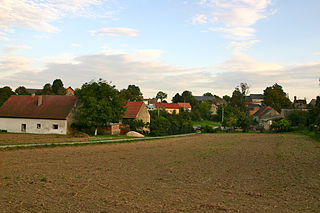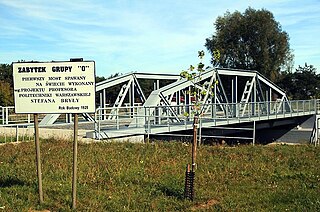
The National Heritage Board of Poland (Polish : Narodowy Instytut Dziedzictwa NID) is a Polish governmental institution responsible for the objects considered most important to the nation's cultural heritage. [1] [2]

The National Heritage Board of Poland (Polish : Narodowy Instytut Dziedzictwa NID) is a Polish governmental institution responsible for the objects considered most important to the nation's cultural heritage. [1] [2]
The institute administers the National Heritage Site lists according to the Ordinance No 32 of the Ministry of Culture and National Heritage (Poland), passed on 23 December 2010. [2] The objects protected include A) immoveable sites, B) moveable objects and C) archeological monuments. [2] These three basic types are classed into three levels of National Heritage Sites, which are firstly the List of World Heritage Sites of Poland, secondly the list of Historical Monuments, which are sites named by the Prime Minister, and thirdly, the list of cultural heritage. [2]
The institute also keeps a list of national parks protected by the "law article paragraph 16 on the protection of monuments and the guardianship of monuments dated 23 July 2003". [3]
The institute organizes the European Heritage Days in Poland, as well as conducting research on heritage preservation.

Cultural heritage is the legacy of cultural resources and intangible attributes of a group or society that is inherited from past generations. Not all legacies of past generations are "heritage", rather heritage is a product of selection by society.

Zwierzyn is a village in Strzelce-Drezdenko County, Lubusz Voivodeship, in western Poland. It is the head of the gmina called Gmina Zwierzyn. It lies approximately 6 kilometres (4 mi) south-east of Strzelce Krajeńskie and 25 km (16 mi) north-east of Gorzów Wielkopolski.

Jałowiec is a village in the administrative district of Gmina Lubań, within Lubań County, Lower Silesian Voivodeship, in south-western Poland. Prior to 1945 it was in Germany and had the name Wingendorf.

Lisięcice is a village located in the Opole Voivodeship, Głubczyce County, Gmina Głubczyce. It lies approximately 8 kilometres (5 mi) north-east of Głubczyce and 46 km (29 mi) south of the regional capital Opole.

Zadzim is a village in Poddębice County, Łódź Voivodeship, in central Poland. It is the seat of the gmina called Gmina Zadzim. It lies approximately 16 kilometres (10 mi) south-west of Poddębice and 43 km (27 mi) west of the regional capital Łódź.

Królowe is a village located in the Opole Voivodeship, Głubczyce County, Gmina Głubczyce. It lies approximately 7 kilometres (4 mi) north-east of Głubczyce and 47 km (29 mi) south of the regional capital Opole.

Czyżowice is a village in the administrative district of Gmina Prudnik, within Prudnik County, Opole Voivodeship, in south-western Poland, close to the Czech border. It lies approximately 5 kilometres (3 mi) north of Prudnik and 42 km (26 mi) south-west of the regional capital Opole.

Dębowiec is a village in the administrative district of Gmina Prudnik, within Prudnik County, Opole Voivodeship, in south-western Poland, close to the Czech border. It lies approximately 6 kilometres (4 mi) south-west of Prudnik and 51 km (32 mi) south-west of the regional capital Opole.

Objects of cultural heritage in Poland are tracked by the National Heritage Board of Poland.

The osiedleOld City is the oldest historic district of the city of Zamość. It is one of World Heritage Sites in Poland. According to UNESCO, this monument value lies in it being "an outstanding example of a Renaissance planned town of the late 16th century, which retains its original layout and fortifications and many buildings of particular interest, blending Italian and Central European architectural traditions.". The Medieval Town has an area of 75 ha and a buffer zone of 200 ha.

Węgierki Palace - historic palace in Węgierki. Since 1974 national heritage site.

Ostrowo Szlacheckie Palace is a historic palace in Ostrowo Szlacheckie. Since 1977 national heritage site.

Medieval Town of Toruń is the oldest historic district of the city of Toruń. It is one of World Heritage Sites in Poland. According to UNESCO, its value lies in its being "a small historic trading city that preserves to a remarkable extent its original street pattern and outstanding early buildings, and which provides an exceptionally complete picture of the medieval way of life". The Medieval Town has an area of 60 ha and a buffer zone of 300 ha. It is composed of the Toruń Old Town, Toruń New Town, and the Toruń Castle.

The Maurzyce Bridge over the Słudwia River in Central Poland is the first entirely welded road bridge and the second welded bridge of any category in the world. The bridge is located close to the village of Maurzyce near Łowicz in Łódź Voivodeship.
Registry of Objects of Cultural Heritage in Poland is a heritage register for Polish objects of cultural heritage. It is maintained by the Voivodeship Office for Preservation of Objects of Cultural Heritage.
Culture park, in Poland, is a designation in the heritage register for cultural landscape-level objects of cultural heritage in Poland.

The Małopolska Institute of Culture is a regional cultural institution engaged in promoting and supporting the culture of Małopolska. The Institute was founded in 2002 and is located in Kraków. Its main focus is integrating diverse small regional cultural institutions - museums, archives or local cultural centres.

Preachers' House (also House of Three Preachers; in Polish Dom Kaznodziei or Dom Trzech Kaznodziei) is a mannerist townhouse in Gdańsk, Poland. It is located on Katarzynki Street, in the centre of the historical Old Town.

The Church of St. Peter and St. Paul is a Lutheran church and a historical landmark in the town of Pabianice in central Poland. Constructed in the early nineteenth century to cater to the spiritual needs of the growing Protestant population of the rising industrial town, the church now serves a small Lutheran community in what is a predominantly Catholic area. Since 2010 the church has been the seat of the bishop of the Lutheran Diocese of Warsaw.